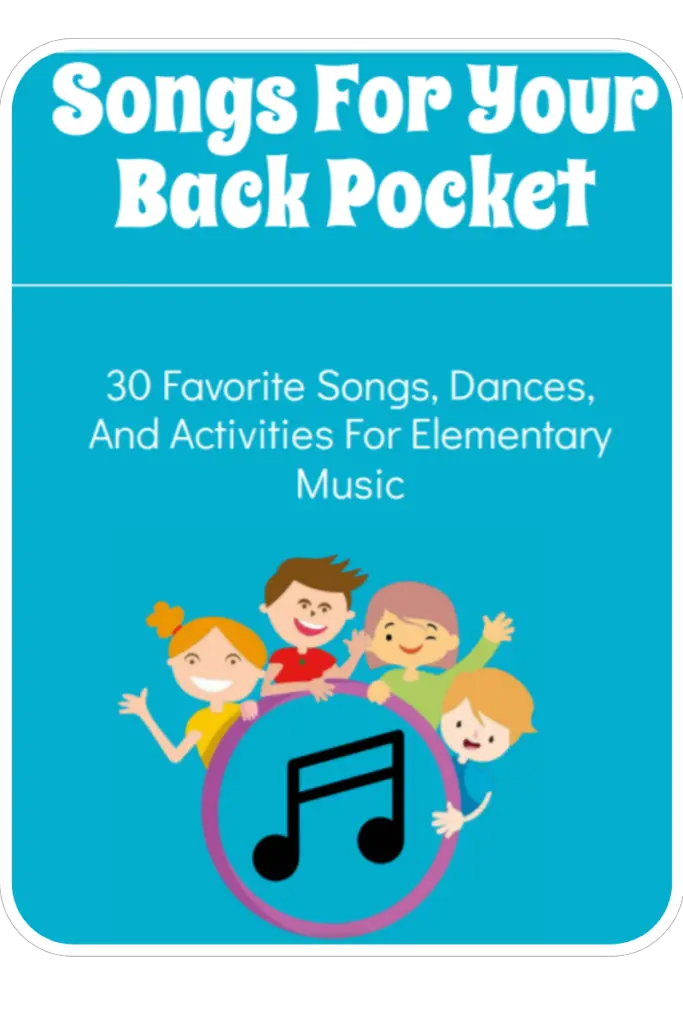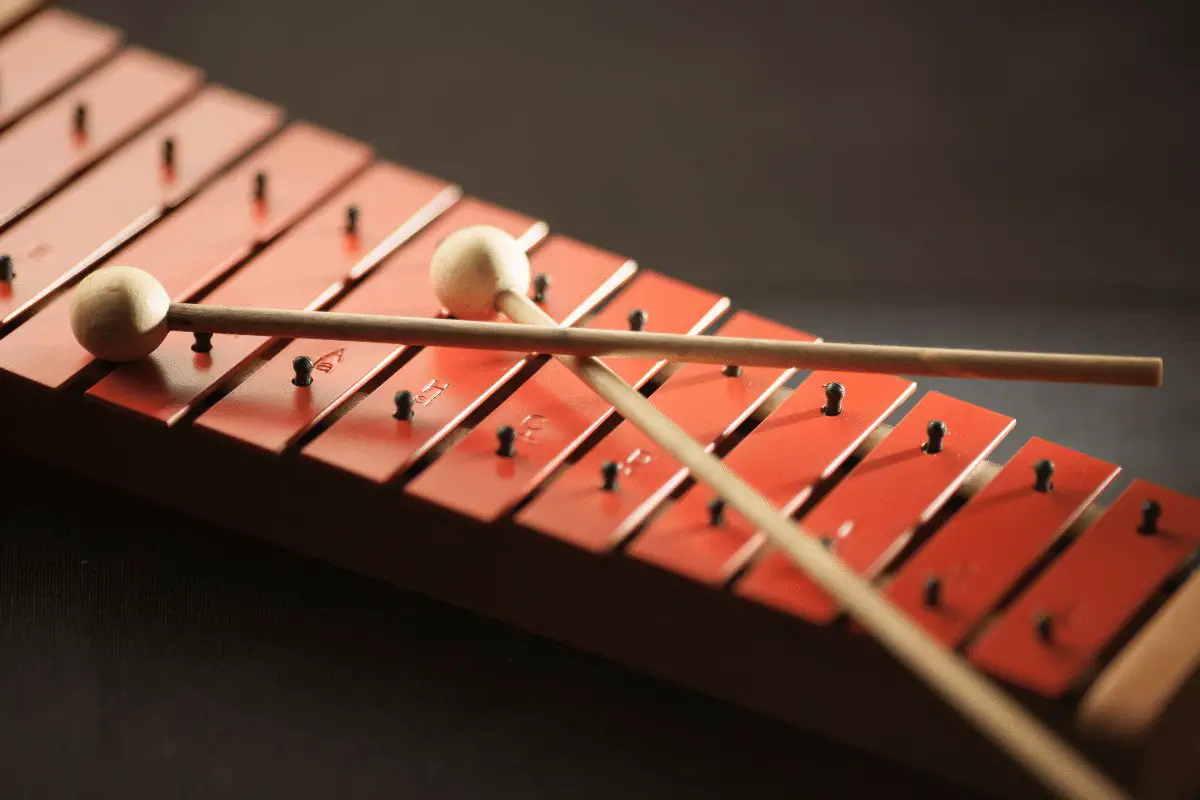Orff xylophones are a great way to introduce a lot of pitch elements and concepts to your music students at any age.
Playing each pitch is as simple as striking it with a mallet, and it trains their ears to know what to listen for.
I don’t think this should be used as a replacement for singing, but a supplement or partner, xylophone activities and songs are perfect!
With this in mind, I compiled a list of my favorite xylophone lesson plans to share with you for FREE.
- Introducing The Xylophone
- All Around The Brickyard
- Miss Monroe
- Xylophone Listening Lesson (Dance Macabre)
- The Noble Duke Of York
- Button You Must Wander
- Compose Your Own Patterns
- Halloween Lesson
- All Through The Night
- Sally Go ‘Round The Sun

Save time with these 60 FREE Music Resources to use in your room right away!
Stop searching the whole internet to find good activities. I’ll help you cut to the chase with my favorite 60 FREE resources.
Table of Contents
Introducing The Xylophone
The first thing I do, almost year-after-year, is make sure the xylophone procedures are set and practiced.
One of the biggest complaints music teachers have about xylophones is how chaotic a classroom can get with them.
When there are dozens of students all playing at the same time the volume level increases, things get broken, and frustration skyrockets.
But it doesn’t have to be this way.
My first xylophone lesson follows the same format I’m going to share with you here.
#1 Take a simple song the class knows well.
In younger grades, this may be something like Twinkle Twinkle or Johnny Works With One Hammer.
Older grades may have something more complex.
Since I don’t know what you teach, I can’t pick for you, so take a look at what you’ve taught to decide.
#2 Practice an ostinato or beat pattern on the legs first.
This is preparing students for the motion they’ll do on the xylophone.
Let’s stick with the youngest students for this example.
With Twinkle Twinkle, I’d have them just keep a steady beat on their legs.
First, I’ll have them pat; then, I’ll have them tap their laps with just their pointer fingers.
Here’s the most important part though:
Make it clear you start and end with your fingers up.
This is the procedure you’ll want for the xylophones too.
#3 Review Xylophone safety procedures and practice beat on xylophone with fingers.
Go over simple and basic rules for Xylophones:
- Don’t lift bars without permission.
- Don’t play unless you’re told to.
- Never step OVER the Xylophones.
- Fingers or sticks up at the beginning and end.
- Strike the bar in the middle of the bar, not on the edges.
Move students to the Xylophones small groups at a time.
Have them practice on a simple pattern (tapping the note C for Twinkle Twinkle).
#4 After all have had a turn, use sticks. Reinforce good posture.
Once everyone’s got a chance to play with fingers, now it’s time for sticks or mallets.
Review good holding posture (like you’re riding a bike, not stabbing a piece of meat or hitting with a hammer).
Connect the earlier procedures with fingers now with sticks.
Praise when people do the right thing! This is the most effective way to reinforce, over consequences (but don’t be afraid to take them away if they can’t handle it).
Repeat the previous step with all the students.
#5 Add a Grand Finale!
Do all the above once more, but this time, let them play a roll or Grand Finale on the tonic pitch of your choice.
I really want to end on a high note (pun intended), so I make sure to end a first experience in the year on the barred instruments with a finale like this.
Note: With older students, you may also want to add taking off and putting on xylophone bars to your practice procedures.
Further Reading: Orff Instruments and where they come from
All Around The Brickyard
This is a great Orff lesson for teaching improvisation.
Take off the unnecessary notes and teach the beat or bordun pattern.
On the B section (where they count), let students pick any notes they want and play them to the beat.
The only requirement they have is to end on tonic or Do when they get to number 8.
Further Reading: Xylophones for kids: What to buy?
Miss Monroe
This is one of the first Orffestration lessons I use because all the parts get connected to the words in the song.
There are different layers here, and there are also parts that simply accent the song.
As an extension, let students create their own lyrics for the song.
Then, make a whole Rondo form where you perform the original in between each group’s individual version.
This one hits many music theory concepts and is a great 3rd grade music lesson.
Further Reading: Rondo songs for music class
Xylophone Listening Lesson (Dance Macabre)
This is one of the most famous examples of xylophones and an example of timbre being used for a specific purpose.
In this piece, the xylophone is used to mimic the sound of bones.
(It’s also used for this in the song Be Prepared from the Lion King.)
This song serves as a great launching point for both a listening discussion of a piece and also a bit about the xylophone and pitched instruments in general.
Questions for this piece:
- How would you describe the tempo?
- How would you describe the dynamics?
- What instruments do you hear?
- How does the instrument choice affect the song?
- Where do you hear the xylophone?
- What does it remind you of?
- How does the piece make you feel?
Discussion points on the xylophone:
- Pitched percussion
- Other percussion instruments: marimba, glockenspiel, etc.
- Material and how it changes the timbre or sound (this is a great science connection)
- History of the xylophone
- First use in classical music (Humperdink’s Hanzel and Gretel)

Tired of searching and searching for songs that work?
I’m saving you headaches and wasted time spent looking for good activities with this eBook of my 30 favorite songs, dances, and activities for elementary music. Get back to making music right now!
The Noble Duke Of York
With a fun song and movement game, this song also makes a good beginner Orff activity on the xylophone.
Further Reading: Noble Duke of York Lesson and Game
Button You Must Wander
If you’ve seen me present, you’ll notice I almost always include this song.
I use it a ton, and it’s one of my favorites.
It’s just so catchy!
Further Reading: Button You Must Wander Lyrics and Game
Compose Your Own Patterns
One of the best parts of the xylophone (at least elementary xylophones) are how you can remove bars to make a specific scale.
Along these lines, I like to use this to provide students the chance to compose patterns or even a song using xylophones.
Use a launching point or an inspiration and allow small groups to compose!
If using a song, let students come up with their own patterns to accompany the song.
If using a poem or story, students can add melody to create a song.
Pro-tip: This only works if they have a lot of experience with different patterns with other songs.
Halloween Lesson
I’m not above using what other people have come up with, and you shouldn’t be either.
Sometimes it’s OK to put on an elementary music lesson video and follow along yourself.
When we student teach, we learn the most because we’re watching someone else do it.
This is the SAME idea with videos like this one.
I love watching what others come up with. Collectively, we are creative folks and make our field better!
Do the same with holiday music too!
All Through The Night
Don’t forget: students can learn a lot about melody too by playing melody on the xylophone.
For things like that, though, you’ll want to start with simple songs like this one.
Check it out on Beth’s Notes.
Sally Go ‘Round The Sun
I’ll use this song with my youngest kids and have them practice playing specific notes at different spots.
It’s a great way to emphasize the parts of a song and how xylophones and other musical instruments may be used.

Save time with these 60 FREE Music Resources to use in your room right away!
Stop searching the whole internet to find good activities. I’ll help you cut to the chase with my favorite 60 FREE resources.

